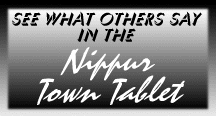

[p. 118] [The temple] comprised an area intended to [p. 119] be six hundred and fifty feet square by outer measurement. By an error of a sort of which there are not a few in various parts of the building, proving the lack of instruments of precision, the eastern angle was made obtuse instead of right, thus lengthening unduly the northeastern and northwestern walls, and forming an irregular four-sided figure. This area was enclosed by a huge wall of unbaked brick with irregular tower-like masses at the corners. On the southeastern side, or front, this wall still stands to the height of more than sixty feet, about fifty feet thick at the bottom and thirty at the top. On this, around the whole extent of the temple, were rooms and corridors. The surface within this enclosure was filled up to more than half the height of the wall with a mass of rubble and d�bris, which formed the foundation for a great number of various structures, constituting a small city in itself. Within the wall on the southeastern side was a large, deep corridor or passageway, and beyond this a second wall, relieved by two solid round towers. Within this, at a slightly higher level than the corridor, were a number of rooms and chambers, kitchens, storerooms, rooms used in connection with ablutions and purifications, and many more, the use of which we do not certainly know.
Still moving inward in a direct line we ascend a narrow platform, beyond which rises steeply in two terraces the solid mass of the ziggurat proper, a rectangular oblong, with irregular, buttress-like projections on all four sides, surmounted, apparently, by a small brick building. This formed the apex or summit of the whole mass. It was surrounded on three sides by chambers, forming terraces beneath it, and on the fourth side it backed closely on the retaining wall. Such was substantially the form of the temple of Bel [Enlil], or the building which occupied the site of that temple, as I found it -- singularly lacking, it must be confessed, in architectural grace, and rude in [p. 120] material, but possessing a massive grandeur due to its vast bulk, and the mountain-like appearance which it presented in the midst of that level country.
The corners of this building pointed toward the cardinal points. The same peculiarity had been noticed by the earlier explorers at Ur, Borsippa, and elsewhere, and much has been written about the astronomical and religious purposes of such an arrangement, and the mathematical precision of the measurement. I found this orientation to be merely approximate. The corner of the ziggurat at Nippur was twelve degrees east from the magnetic north, and I observed about the same deviation at Ur and Erech. In the case of another ruin I found the divergence to be as great as twenty degrees. This orientation of temples and other buildings depended, I think, at least at the outset, on natural conditions, and not on astronomical and religious theories. The buildings of the natives of the present day are apt to be arranged in the same manner in order to catch the wind; for the rivers and the valley trend from the northwest to the southeast, and the prevailing winds follow the same course. Every one, therefore, turns his house with a side to the northwest for coolness' sake, rather than for astronomical theories, and this brings the corners of all buildings approximately toward the cardinal points.
This excerpt is taken from John Punnett Peters, Nippur or Explorations and Adventures on the Euphrates: The Narrative of the University of Pennsylvania Expedition to Babylonia in the Years 1888-1890, New York: G.P. Putnam's Sons, 1897, Volume II, pp. 118-120.
Click on these links to navigate our site:


| Sign My Guestbook | View My Guestbook |